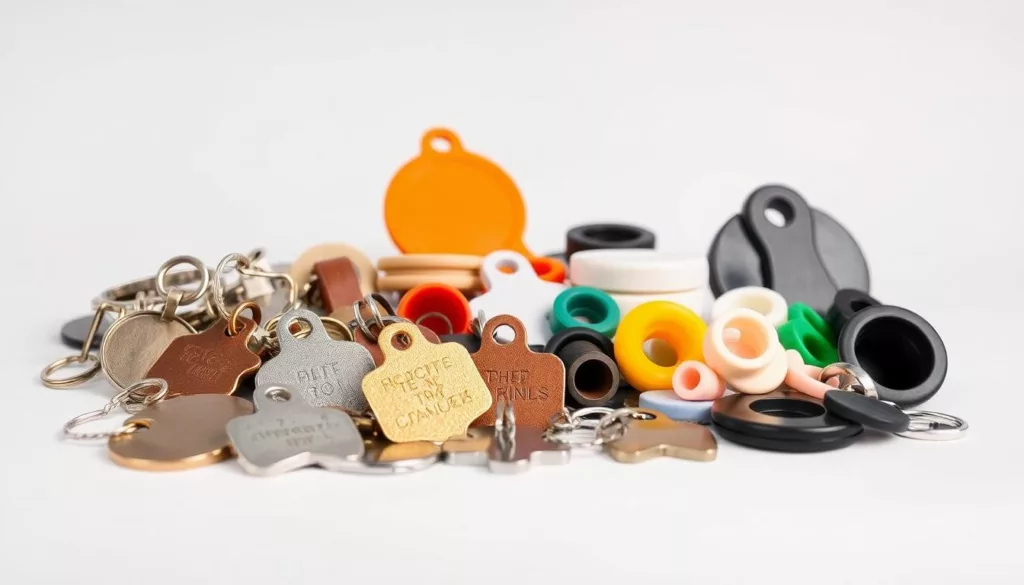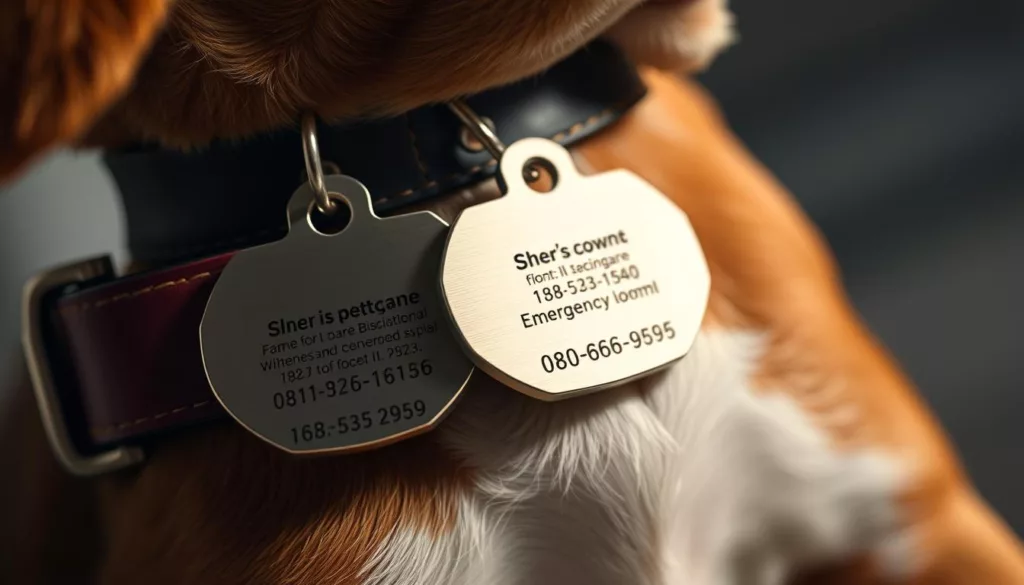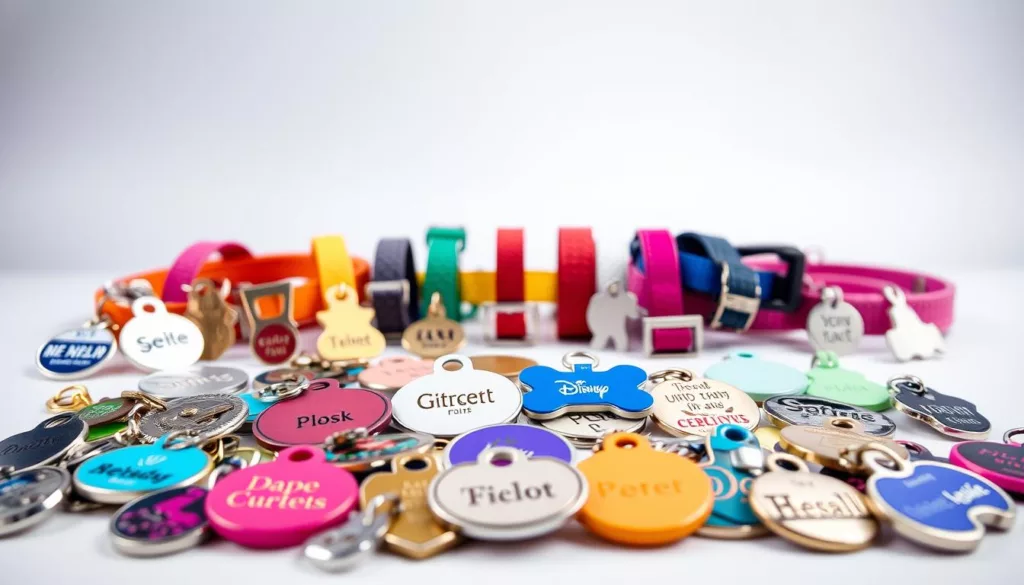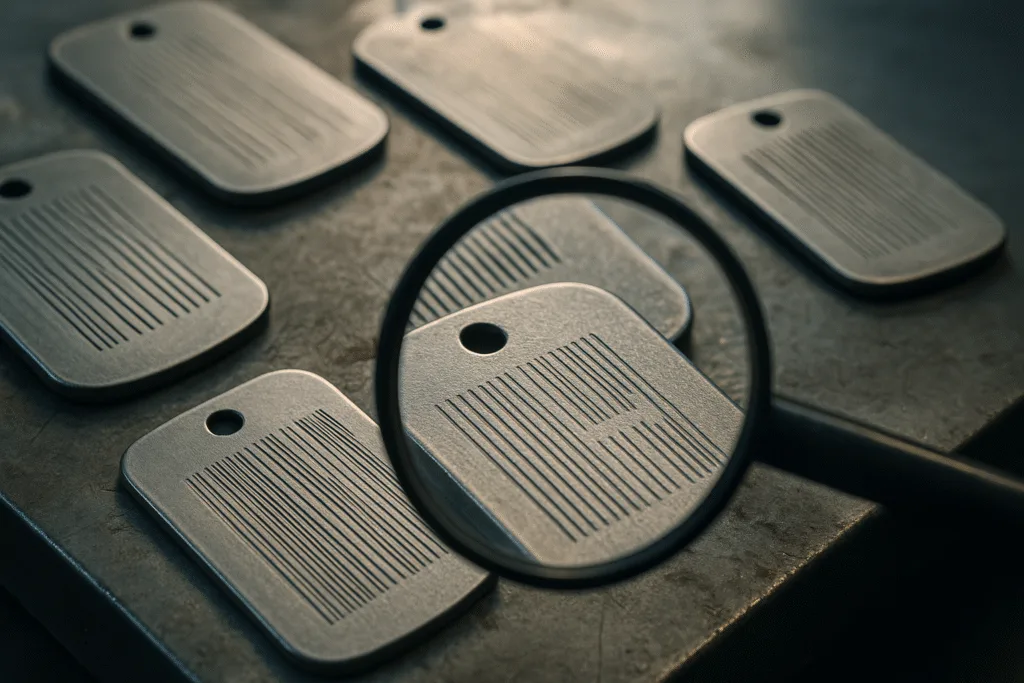Pet ID tags are crucial for keeping dogs safe and ensuring they return home quickly. They act as identification, providing vital information that helps dogs find their way back. It’s important for pet owners to know what to include on these tags to help in emergencies.
This article will cover the essential details for pet ID tags. We’ll focus on the information that protects your pet and meets the needs of pet owners and businesses. This includes the best practices for making these tags effective.
Key Takeaways
- Pet ID tags are essential for identifying lost dogs.
- Include your dog’s name and owner contact details.
- Consider adding medical information if applicable.
- Understand local and state requirements for pet ID tags.
- Select durable materials for increased longevity.
- Explore customization options for a personal touch.
Importance of Pet ID Tags
Pet ID tags are crucial for pet safety. Every dog owner should have a visible form of dog identification. An ID tag can greatly increase the chances of a lost pet being returned home quickly.
Why Every Dog Needs an ID Tag
ID tags provide immediate identification for dogs. They make it easier for someone to return a found pet to its owner. A collar with a tag offers essential contact information at a glance.
This quick access to owner details enables prompt reunions. This is vital in any situation involving lost pets.
The Impact of Microchipping vs. Tagging
While microchipping is a valuable option for dog identification, it should not replace traditional ID tags. Microchips require specialized scanning equipment and might not always be used by finders. Tags, on the other hand, offer straightforward identification without additional technology.
Studies show that dogs wearing ID tags are returned home up to 20 times faster than those without. This statistic highlights the critical nature of having an ID tag readily available on every dog.
Maintaining a focus on the importance of pet ID tags allows pet owners to take proactive steps in safeguarding their furry friends. With effective dog identification solutions, the chances of a swift recovery increase significantly.
Essential Information for Dog ID Tags
Dog tags hold vital information that helps bring pets back home quickly. They act as identification and can save lives in emergencies. It’s crucial to include the right details.
Name and Contact Information
Every dog tag should clearly show the dog’s name and the owner’s contact info. This lets anyone who finds the dog contact the owner fast. It’s smart to include:
- Owner’s full name
- Phone number
- Alternate contact method, such as an email address
Having clear identification details increases the chances of a lost pet being found.
Medical Information (if applicable)
If your dog has health issues or allergies, add this info to the tag. It could be:
- Allergies
- Chronic conditions
- Current medications
Keep the text short and simple. This way, anyone who finds your dog can act quickly and safely.
Legal Requirements for Pet ID Tags
Pet owners must follow legal rules for pet ID tags. Different places have their own laws about what pet ID tags must say. These laws often require tags to show a pet’s license, rabies shot, or other permits.
Knowing these licensing requirements helps keep pets safe and legal.
Local Licensing Laws to Consider
Laws about pet ID tags vary by area. It’s important for pet owners to learn what their local laws say. Some places have special rules for the color or shape of tags to make them easy to spot.
ID Tag Regulations by State
States also have their own rules for pet ID tags. Each state might have different rules about what to include. Not following these rules can result in fines.
It’s best to check with local vets or town halls for the latest legal info.
Choosing the Right Material for ID Tags
Choosing the right ID tag material is key to your pet’s safety. Metal and plastic tags have their own benefits and drawbacks. It’s important to think about what your customers need and the environment your pet will be in.
Metal vs. Plastic: Pros and Cons
Metal tags, like those made from stainless steel or aluminum, are very durable. They can handle tough weather, making them great for pets that spend time outside. Some might find them heavy, but their long life makes up for it.
Plastic tags are lighter and come in many colors and designs. They look nice but might not last as long as metal tags. You need to decide if looks or durability is more important for your pet’s ID tag.
Durability and Weather Resistance
ID tags need to last a long time to keep your pet’s info safe. Metal tags are tough against scratches and fading, perfect for pets that get into rough spots. Plastic tags might fade and could break if they get too wet.
| Feature | Metal Tags | Plastic Tags |
|---|---|---|
| Durability | High resistance to wear | Moderate, may chip or crack |
| Weather Resistance | Excellent, rust-proof | Fair, may fade in sunlight |
| Weight | Heavier | Lighter |
| Design Options | Limited colors, custom engravings | Wide range of colors and designs |
Customization Options for Pet ID Tags
Custom pet ID tags come with many choices to suit different tastes. You can find unique designs, like fun shapes or bright colors. These options make the tags stand out and appeal to more people.
Unique Designs and Shapes
Pet ID tags with special designs grab attention. They let you show off your pet’s personality. You can choose from:
- Bone-shaped tags
- Heart-shaped tags
- Stars and other creative silhouettes
- Color variations that match pet collars
Personalization with Engravings
Engravings add a personal touch to pet ID tags. They can hold important info like your pet’s name or your contact details. This makes the tags more than just identification; they become keepsakes. You can engrave:
- Names
- Phone numbers
- Special phrases or quotes
How to Keep ID Tags Secure
Keeping ID tags safe is crucial for getting lost dogs back to their owners. Different ways to attach tags make them stay put during play or walks. This helps prevent them from falling off.
Options for Attaching Tags to Collars
There are many ways to keep ID tags securely attached:
- Split Rings: These are a classic choice. They let tags slide onto the collar easily.
- Clip Attachments: They have a lock that makes removing and putting back tags simple.
- Snap Closures: This method keeps tags tight, making it hard for them to fall off.
Regularly Checking Tag Security
It’s important to check on tag security often. This keeps them visible and easy to read. Here’s how to do it:
- Check if the attachment is still good.
- Look for any scratches or wear that might hide the info.
- Swap out any damaged tags to keep them clear.
Updating Information on Your Dog’s ID Tag
Keeping your dog’s ID tag up to date is key for their safety. Changes like new owners, moving, or updated contact info are important. This way, if someone finds your pet, they can reach you quickly.
When to Update Your Tag Information
It’s important to update your dog’s tags during big life changes. Here are some times to do it:
- Change of ownership
- Relocation to a new address
- New contact information, including phone numbers
- Changes in medical conditions or special needs
How to Ensure Always Accurate Info
To keep your dog’s tags current and correct, try these tips:
- Check the tag info regularly.
- Save emergency info online for easy updates.
- Choose tags made of durable materials to last longer.
- Engrave important medical info or special needs.
Popular Pet ID Tag Brands
The pet ID tag market has many well-known brands. These brands are known for their quality and unique features. It’s important to research and compare different brands to find the best one for you.
Key Players in the Market
- Petco: Offers a wide range of customizable tags for those who love personal touches.
- Red Dingo: Known for its stylish and durable tags that stand out.
- Bone Appetit Tags: Appeals to the young with its fun shapes and bright colors.
- Tagg: Offers tech-savvy tags with GPS tracking for the modern pet owner.
Noteworthy Features of Each Brand
| Brand | Unique Features | Target Audience |
|---|---|---|
| Petco | Custom engravings, multiple materials | Personalized pet owners |
| Red Dingo | Attractive designs, durable metal | Style-conscious pet owners |
| Bone Appetit Tags | Varied shapes, colorful options | Fashion-forward consumers |
| Tagg | GPS tracking, smartphone integration | Tech-savvy pet parents |
Best Practices for Pet ID Tags
To make sure your pet can be easily found, it’s important to use the right ID tags. Choose tags with colors that stand out. This makes it easier for anyone to read your pet’s information if they get lost.
Make sure the tags are big enough. Small tags can’t fit all the important details. This can make it hard to get your pet back.
Being a good pet owner means more than just feeding and walking your pet. It also means making sure they have ID tags. Teaching pet owners how important these tags are can help keep pets safe.
UC Tag is all about making high-quality, easy-to-read ID tags. They help pet owners understand how crucial clear tags are for pet safety. This way, more pets can be found and returned home safely.
FAQ
What essential information should be included on a dog tag?
A dog tag should have the pet’s name, a contact number, and any medical info. This helps anyone find the dog and know how to contact the owner. It also lets them know if the pet has any health needs.
Why is it important to have both a microchip and an ID tag?
Microchips are permanent, but they’re not a replacement for ID tags. ID tags are easy to spot and don’t need any tech to read. They greatly increase the chances of a lost dog being found and returned home fast.
Are there legal requirements for pet ID tags?
Yes, many places have laws about pet ID tags. These laws might cover things like if the pet is licensed or if it’s up to date on rabies shots. It’s important for owners and makers to know these laws to avoid fines.
What materials are best for dog ID tags?
Dog ID tags are usually made of metal or plastic. Metal tags, like stainless steel or aluminum, are more durable and last longer. Plastic tags are lighter but might not last as long.
How can I customize my dog’s ID tag?
You can make your dog’s ID tag unique with shapes, colors, and engravings. Making it special strengthens the bond between you and your pet.
What are the best practices for attaching ID tags to collars?
There are a few ways to attach ID tags to collars, like split rings or snap closures. It’s important to check the tags often and replace them if they get damaged. This keeps the tags readable.
When should I update my dog’s ID tag information?
Update your dog’s ID tag when there’s a change, like a new owner or a move. Regular checks help keep the info up to date.
What are some popular brands for pet ID tags?
Popular brands include Petco and Red Dingo. Petco offers lots of customization options. Red Dingo is known for durable and stylish tags. Each brand has something special for different tastes.
How can I ensure my dog’s ID tag stays legible?
Choose tags with clear colors and big enough for all the info. Teach pet owners about the importance of clear tags to prevent loss.





